The effects of building barriers along the Texas-Mexico border will cause habitat loss and habitat fragmentation, separate riparian habitat from the rest of Texas (because barriers have to be built back from the river), and will affect many different kinds of plants and animals (Fowler et al. 2018). UT press release and interviews with authors
Carolyn
Whiting, in collaboration with US Fish and Wildlife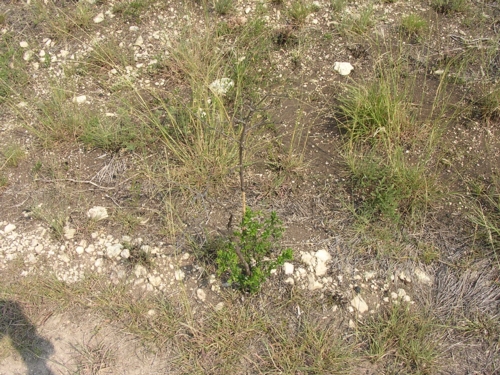 Service
biologists
and several undergraduates, is studying the effects of fire on a
savanna community with a replicated experiment that includes
manipulating the date of prescribed fire. The results will
increase our
understanding of the effects of fire on savanna plant communities,
including grasses, forbs, and woody species. Of particular interest is
whether the invasive non-native grass King Ranch bluestem (Bothriochloa ischaemum)
responds differently to fire than do the native grasses. We hope that
this
experiment will also help us find a way to use fire to control this
invasive
species.
Service
biologists
and several undergraduates, is studying the effects of fire on a
savanna community with a replicated experiment that includes
manipulating the date of prescribed fire. The results will
increase our
understanding of the effects of fire on savanna plant communities,
including grasses, forbs, and woody species. Of particular interest is
whether the invasive non-native grass King Ranch bluestem (Bothriochloa ischaemum)
responds differently to fire than do the native grasses. We hope that
this
experiment will also help us find a way to use fire to control this
invasive
species.
Whitney Behr, Carolyn Whiting, and Kyle Simpson, in collaboration with members of Dr. Shalene Jha's research group, are participating in an experiment to determine the effects of fire and re-seeding on pollinator resources. We are determining the effects of the prescribed fire treatment on forb species. We are also quantifying the behavior of the fires in the prescribed fire treatment to determine the effects of the fire treatment on the abundances of different grass species and on future fuel properties.
Christina Andruk (Ph.D. 2014) studied the effects of fire and seeding on an herbaceous plant community in collaboration with US Fish and Wildlife Service biologists. Andruk & Fowler 2011
Another former student, Karen Alofs (Ph.D. 2010) studied the effects of habitat fragmentation caused by juniper encroachment in central Texas savannas. Encroachment reduced the amount of habitat for herbaceous species and fragmented it, both of which reduced the diversity of herbaceous plant species. However, juniper encroachment also partially blocked the spread of King Ranch bluestem. Since King Ranch bluestem outcompetes native herbaceous species (Gabbard and Fowler 2006), there was also a short-term small positive effect of juniper encroachment on herbaceous species (Alofs and Fowler 2010, 2013, 2014).
Christina Andruk (Ph.D. 2014), in collaboration with US Fish and Wildlife Service biologists and several undergraduates, studied the role of deer browsing and fire in oak-juniper woodlands of the eastern Edwards Plateau. Both excessive deer browsing and a lack of surface fire are negatively affecting oak regeneration. Andruk & Fowler 2010
Kevin Doyle
(M.A. 2012) took advantage of prescribed savanna fires that
burned
into neighboring woodlands to study the effects of
deer browsing and fire in a range of sites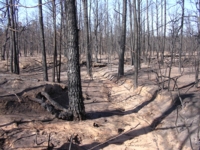 and species.
and species.
The wildfires of September 2011 burned much of the Lost Pines, which are the westernmost populations of loblolly pine (Pinus taeda). Taking advantage of pre-wildflire data collected by the Texas Parks and Wildlife Department at Bastrop State Park, Emily Booth (Ph.D. 2017) studied the recovery of these pine-oak woodlands after the 2011 wildfires, in collaboration with TPWD staff biologists and several undergraduates. Oak re-sprouting was immediate. Pine regeneration was delayed until a year of higher precipitation produced a successful cohort of pine seedlings.
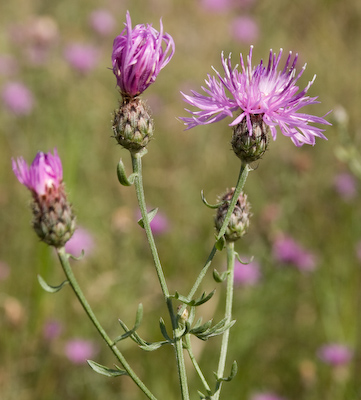 w
York State
w
York StateAshley Green, in collaboration with faculty and students at Stony Brook University in New York, is modeling the dynamics of a large set of spotted knapweed populations in the Adirondack Mountains and on Long Island in New York state. Spotted knapweed is currently invading these regions. The project focuses on landscape demography (Gurevitch et al. 2016) and the demographic differences among populations within and between the two regions.
Since 1983 an annual census has been made of a set of
permanent plots
located in open grassy patches in a live oak/Ashe juniper savanna in
central Texas. Data from thes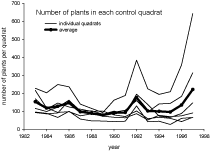 e
plots have
provided the basis for an
ongoing study of plant population dynamics and regulation
of the native perennial grass Bouteloua rigidiseta
(Texas grama grass). Earlier studies focused on population
regulation (e.g., Fowler and Pease 2010; Fowler
et al. 2006). As
the invasive non-native grass King Ranch bluestem has invaded the
permanent plots, it has become a study of the effects of this invasive
species on the demography of other plant species.
Several UT undergraduates have done research projects using subsets of
this large
data set.
e
plots have
provided the basis for an
ongoing study of plant population dynamics and regulation
of the native perennial grass Bouteloua rigidiseta
(Texas grama grass). Earlier studies focused on population
regulation (e.g., Fowler and Pease 2010; Fowler
et al. 2006). As
the invasive non-native grass King Ranch bluestem has invaded the
permanent plots, it has become a study of the effects of this invasive
species on the demography of other plant species.
Several UT undergraduates have done research projects using subsets of
this large
data set.
In collaboration with Martin Terry, a Sul Ross University faculty
member and others, we are studying the population dynamics and
conservation of several cactus species. A series of publications
documents the legal over-harvesting of Lophophora williamsii,
threatening its persistence (e.g., Terry et al. 2014).
Recently Olivia Schmidt (M.A. 2017) completed a review of the ecology and conservation status of three rare cactus species and a rare grass species growing in Big Bend National Park.
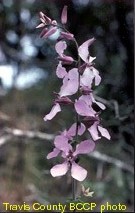
Modeling projects include an IPM of the population dyanamics of King Ranch bluestem and a cellular automata model of woody plant encroachment.
Department of Integrative Biology
EEB graduate program Plant Biology graduate program